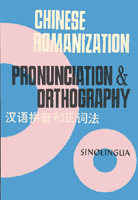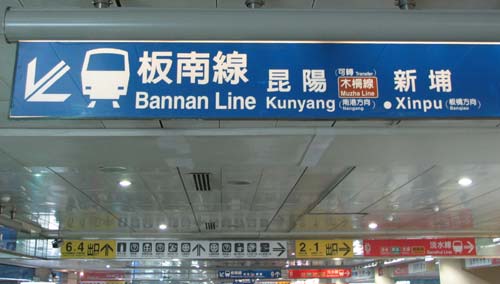 I’ve just put online another excerpt from Yin Binyong’s book about Pinyin. This one covers use of the hyphen in Hanyu Pinyin (400 KB PDF).
I’ve just put online another excerpt from Yin Binyong’s book about Pinyin. This one covers use of the hyphen in Hanyu Pinyin (400 KB PDF).
I’ll summarize some of the basics.
First, I want to stress that in Pinyin a hyphen should never be used to indicate syllable breaks. Those are easy to discern in Pinyin without any such Wade-Gilish clutter — or without any such foolishness as InTerCaPiTaLiZaTion. And in those few cases that might otherwise be problematic, the apostrophe works nicely.
OK, so what are the correct uses of the hyphen in Pinyin? Often, it’s employed much like the en-dash in English, for ranges and connections. And it’s also used in many abbreviated forms, esp. in cases with proper nouns.
- the road on Taiwan’s east coast between Sua’ao and Hualian: the Su-Hua Expressway
- the rail line between Beijing and Tianjin is the Jing-Jin line (京津城际铁路)
- Beijing Daxue (Peking University) –> Bei-Da (not Beida)
- Guólì Táiwān Dàxué (National Taiwan University) –> Tai-Da (not Taida)
- English-Chinese dictionary: Ying-Han cidian
In terms of signage, that covers the most frequently encountered needs for the hyphen.

This sign in Taipei Main Station should read “Ban-Nan Line”, not “Bannan Line”, because the line runs between Banqiao and Nangang. (Actually, now it starts farther out, in Tucheng; but it hasn’t been redubbed the Tu-Nan line.)
For most other uses, see the full document. (Or see the older HTML version, which is without Hanzi.)
That section of the book, however, doesn’t mention one minor use of the hyphen in Hanyu Pinyin: hyphenated family names. These days, most women retain their original names when they marry. Formerly, however, a woman would often link her original name with her husband’s family name. Thus, if Ms. Guo Meihua were to marry a Mr. Li, she might choose to become Li-Guo Meihua, just as a Ms. Smith marrying a Mr. White might choose to adopt the name Smith-White (or White-Smith).
Note, however, that hyphens are not used in what are originally two-syllable family names. The well-known historian is Sima Qian, not Si-Ma Qian. (Similarly, Ouyang, not Ou-Yang; Zhuge, not Zhu-Ge.) Such family names, however, are rare.
For more on this, see p. 156 of the section on proper nouns in Pinyin (1.9 MB PDF).
(Wade-Gilish? Wade-Gileish? Wade-Gile-ish? Wade-Gileish? I still can’t figure out how best to style my nonce term. Oh well.)

Taking the leading characters from two geographical locations and smushing them together happens in Japanese, too. For instance the ??? connects ?? and ??. But frankly, writing this in r?maji as the “Do-San Line” 1) looks terrible, 2) is only minimally useful, 3) is not officially part of any Romanization standard that I’m aware of, and 4) is absolutely never done in practice. So I have to wonder, is this really a worthwhile guideline? Is it actually used in Chinese-speaking areas? Because if someone were to suggest something similar for Japanese I’d have to say “don’t bother, it’ll only increase confusion.”
Pingback: Links 20 October 2008 - David on Formosa
Pingback: New database of cross-strait differences in Mandarin goes online | Pinyin News